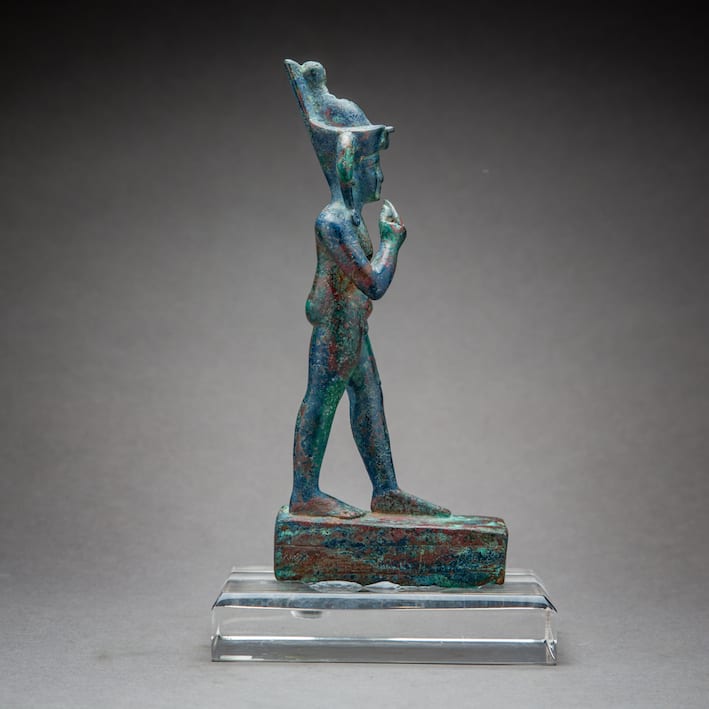Egyptian Bronze Sculpture of Harpocrates, 664 BCE - 332 BCE
Bronze
height 20.6 cm
height 8 1/8 in
height 8 1/8 in
X.0302
Further images
Although not inscribed, the iconography of our statuette is sufficiently complete to insure its identification as a representation of Horus the Child. He is depicted as a nude, husky child...
Although not inscribed, the iconography of our statuette is sufficiently complete to insure its identification as a representation of Horus the Child. He is depicted as a nude, husky child with a decidedly corpulent body. His attitude is that of the canonical, Egyptian striding male figure with his left foot advanced on a rectangular base. His left arm is held down alongside his body and its fisted hand may have originally held a ceremonial staff. His right arm is bent at the elbow and raised so that its extended index finger is placed near the mouth. This hand-gesture habitually denotes children in ancient Egyptian art, but was mistakenly interpreted by the Greek and Romans who maintained that the gesture of the index finger to the lips was one of silence, indicating that Harpocrates would not reveal hidden wisdom to outsiders. Our child god’s only attribute is the Double Crown which is fronted by a uraeus, or sacred cobra.
Harpocrates wears the Double Crown as an emblem of his role in Egyptian mythology. As the son who avenged the death of his father, Osiris, at the hands of Seth, Horus the Child was regarded as the legitimate successor of his father. Consequently, each deceased pharaoh was identified as Osiris, and each successor with Horus. The Double Crown is, therefore, to be regarded as the emblem of legitimate kingship in this particular context.
On the basis of parallels, one can date our Harpocrates to the Late Period. At that time such statuettes were dedicated by pious pilgrims at various sanctuaries throughout the land in order to secure the deity’s blessings. (X.0302)
References:
Jean-Claude Grenier, Les bronzes du Museo Gregoriano Egizio (Vatican City 2002), page 29, catalogue number 29 [inventory number 18576], for a very close parallel which even exhibits the same surface as our example.
Harpocrates wears the Double Crown as an emblem of his role in Egyptian mythology. As the son who avenged the death of his father, Osiris, at the hands of Seth, Horus the Child was regarded as the legitimate successor of his father. Consequently, each deceased pharaoh was identified as Osiris, and each successor with Horus. The Double Crown is, therefore, to be regarded as the emblem of legitimate kingship in this particular context.
On the basis of parallels, one can date our Harpocrates to the Late Period. At that time such statuettes were dedicated by pious pilgrims at various sanctuaries throughout the land in order to secure the deity’s blessings. (X.0302)
References:
Jean-Claude Grenier, Les bronzes du Museo Gregoriano Egizio (Vatican City 2002), page 29, catalogue number 29 [inventory number 18576], for a very close parallel which even exhibits the same surface as our example.







